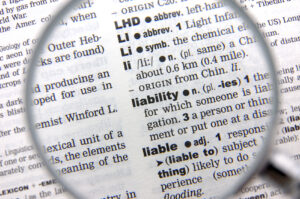
When accidents occur, they may leave you with physical, emotional, and financial injuries. After such an incident, you may be entitled to compensation. One question frequently arises in such situations: who pays for your damages? The answer to this question requires an explanation of liability.
Understanding liability is essential for both accident victims and those potentially facing legal action. In this guide, we’ll explore what liability means in the context of personal injury law.
What Does Liability Mean?

You might have heard “liability” and “liable” used in everyday contexts. People often say that they are “liable for” something or refer to a certain activity as a liability – but what does that mean?
In the legal context, liability refers to one party’s legal responsibility or obligation. Most often, it means that one party has to compensate another for harm or damages caused by their actions or omissions. In personal injury law, liability determines who is at fault for an accident or injury.
Liability in Personal Injury Law
In personal injury cases (such as those based on car accidents, slip and fall accidents, and much more), liability can arise from various legal theories, including negligence, intentional torts, and strict liability.
Negligence
Negligence is the most common basis for liability in personal injury. It occurs when a person fails to exercise reasonable care, thereby causing harm to another. To prove negligence, plaintiffs must prove each of the following elements:
- Duty of care: The defendant owed a duty of care to the plaintiff to act reasonably and prudently.
- Breach of duty: The defendant breached this duty by failing to meet the standard of care expected under the circumstances.
- Causation: The defendant’s breach of duty directly caused the plaintiff’s injuries.
- Damages: The plaintiff suffered actual harm or damages as a result of the defendant’s actions or omissions.
In negligence, liability stems from the failure to exercise reasonable care.
Intentional Torts
Intentional torts occur when a person deliberately engages in conduct that causes harm to another. Examples include assault, battery, false imprisonment, and intentional infliction of emotional distress.
Unlike negligence, intent to harm is a crucial element in intentional torts. Thus, in these torts, liability comes from a person’s intent to cause harm.
Strict Liability
Strict liability imposes liability on a party, regardless of fault or intent. Under strict liability, a person may be held liable for certain activities or conditions that result in harm, even if they took all reasonable precautions to prevent it.
Product liability cases often involve strict liability, where manufacturers may be held liable for defects in their products, even if these defects were not intentional.
In strict liability cases, the liability arises from breaking a rule or causing harm, whether intentional or not.
Depending upon the circumstances of your case, one or more of these types of liability may be involved. An experienced personal injury attorney can help identify the best path to recovering compensation.
Common Types of Personal Injury Cases
Personal injury cases encompass a wide range of incidents, including:
- Car accidents
- Slip and fall accidents
- Medical malpractice
- Workplace injuries
- Defective products
- Dog bites
- Wrongful death
Each type of injury may involve different types of liability and different avenues for seeking compensation.
When Multiple Parties Are at Fault
In some cases, more than one party may share liability for an accident or injury. This can complicate the determination of who pays and how much. We will explore a few common scenarios in which multiple parties share fault.
Comparative Negligence
In South Carolina, multiple parties may each have partial responsibility for an accident. A common example is when there is a multi-vehicle car accident, and multiple drivers contribute to the accident. In such situations, you can recover even if you are partially at fault.
South Carolina follows a modified comparative negligence system. This means that you can still recover damages, but your recovery will be reduced by the proportion of fault attributed to you. However, if you are 51% or more at fault for the incident, you will not recover any damages.
Vicarious Liability
Under vicarious liability, an employer can be held liable for the actions of their employees. In order to do so, employees must have been acting within the scope of their employment. This depends on multiple factors, including whether the employee was on the clock, on-site, and following workplace protocols. The employer and employee can share liability depending on their respective contributions to the harm.
Laws differ slightly for independent contractors. Generally, the more the contract relationship resembles employment, the more likely the “employer” is liable.
Contact Elrod Pope Accident & Injury Attorneys Today to Schedule Your Free Case Evaluation
If you’ve been injured due to someone else’s negligence or misconduct, it is important to consult an experienced Rock Hill personal injury attorney. At Elrod Pope Accident & Injury Attorneys, we have the knowledge, resources, and dedication to help you pursue the compensation you deserve.
Contact us today at 803-324-7574 to schedule your free case evaluation and learn more about your legal rights and options.

